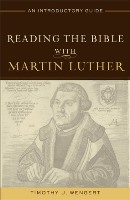Reviewed by Paul Sanchez
Judging by the title, one assumes that Wengert produced this book to encourage Christians to learn from Martin Luther how to read the Bible responsibly, that Luther might be a guide to the Scriptures. He asserts that readers can indeed “hear God’s Word with Martin Luther” (vii). Wengert hopes to challenge the interpretive framework of readers, by looking through Luther. He says that this challenge is against “more fundamentalistic and more liberal methods of biblical interpretation” (vii). Early on and consistently, the reader recognizes that Wengert’s concern is more against the former than the latter. Additionally, by “fundamentalistic,” he has more in mind than those whom historians call fundamentalists. He envisions a broader collection of American Christians under the umbrella of conservative Christianity, ranging from traditional fundamentalists to evangelicals. These Christians have widely misunderstood Luther, making the Reformer in their own inerrantist and generally conservative image. Luther, he argues, is not who they have thought, but instead holds promise for a return to a more faithful Christianity.
Wengert begins with a key Protestant doctrine—the authority of the Bible. Luther was not an inerrantist, nor did he believe in the sole authority of the Bible. American Christians have thoroughly misunderstood Luther on this point, commonly referring to a mantra they wrongly believe encapsulates the Reformation—sola Scriptura. Luther’s use of the book of James demonstrates that Luther was not the fundamentalist that so many American Christians have assumed. Luther was most concerned with the person of Christ and evaluated all books, biblical and extra-biblical, by how well they proclaim Christ. If a source neglected Christ, Luther was content to dismiss it. Solus Christus rather than sola Scriptura best characterizes Luther’s hermeneutic.
Wengert analyzes Luther’s distinction between law and gospel. As with Scripture’s authority, American Christians misunderstand this part of Luther’s thought. He says, “It [his method] is so different, so alien, from any of the methods in current use among American Christians that his immediate descendants sometimes seem embarrassed to talk about it” (22). Some have even used Luther’s distinction in judgment against people’s actions, which is sinful. In short, many have perverted this to undergird ethical legalism, turning Jesus into another Moses or even a Pharisee. Christians should dispense grace, not judgment. He hopes that Luther can help Christians depart from their hypocrisy.
Wengert argues that Luther believed in an inherently weak Bible. On this point, American Christians have most misunderstood Luther. Because of a worldly lust for power, Christians have demanded a powerful Bible, even against the obvious, and against Luther. Luther’s theology of the cross encompasses a weak Bible, and Christians should embrace it and its gospel in its inherent weakness. He says, “in Paul we have a weak message from a weak speaker to weak hearers. And that describes the entire Bible” (50). This weak Bible is neither inerrant nor infallible, for that would take away from its weakness. The value of the Bible lies not in these idols of fundamentalism, but in what it does to the Christian subjectively.
American Christians have also misunderstood Luther on ethics. Luther emphasized charity and equity, while American Christians have emphasized judgment and legalism. Luther did not “begin with rigid principles and categories of behavior and then try to apply them to his circumstances” (70). He worked ethics contextually, on a case by case basis, rather than establishing strict rules for judgment, which is a lazy and even cruel philosophy for ethics. Luther incorporated the principles of common sense and love to guide his ethics, while “Most of us would prefer to throw the book at the neighbor rather than use a more balanced, loving approach” (72). Wengert argues that Luther endorsed ethical solutions that would shock his American successors, including bigamy and divorce for mere marital dissatisfaction. Luther placed love first and fashioned common sense as his guide. Additionally, American Christians have viewed ethics in an overly individualistic manner, whereas Luther thinks in terms of a community.
Wengert uses Galatians 3:6-14 as a test case to examine Luther’s hermeneutic. He expects that this will prove his argument for Luther’s overall distance from interpreters today. Wengert argues against the New Perspective on Paul, contending both that it is not new and that Luther was well aware of proponents of such a view in his own time and in antiquity, namely from Erasmus and Jerome. Luther’s humanist framework primed him to focus on an author’s central idea as a hermeneutical rule. For Galatians 3, Luther saw the text “in light of God’s unconditional mercy in Christ alone and not as a discussion of Jewish ceremonies” (98). Wengert urges readers to follow Luther’s example of finding and clinging to an author’s main point as an interpretative key, rather than degrading to proof-texting. Luther did not stop his exegesis in bare meaning, however, but proceeded to an intended response. Actually, the intended response had bearing on the interpretation. Wengert says, “When the effect of a doctrine led to despair, then, no matter how reasonable the interpretation might seem, it was still false” (121).
Wengert contends that American Christians have polluted Luther. They have thoroughly misunderstood and misapplied him. Wengert’s goal is to recover the authentic Luther from captivity in American conservative religion. However, proving his point would require a much more extensive and careful work. If he is right, he has not demonstrated why so many for so long have so misunderstood Luther. His frustration with conservative Christians is evident throughout the work. However, some might appreciate his candor. As for this book functioning as a guide to Luther’s interpretation of the Bible, its usefulness is limited. However, this work could serve well as an example of a liberal or mainline approach to the Bible and Christianity in general. If Wengert believes that American fundamentalists have made Luther in their image, perhaps he has similarly made Luther in his own.
Paul Sanchez is a student at SBTS pursuing a PhD in Church History.
